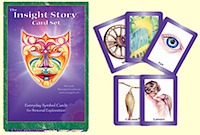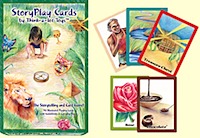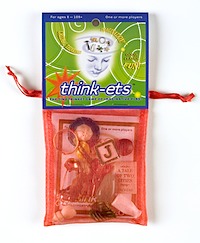By Sheri Harshberger
A couple years ago, I read a book by Lon Milo DuQuette called The Book of Ordinary Oracles and it really changed my reading world. There was a lot of confirmation because I really felt that I wanted to expand my reading tool kit outside of the more "traditional" oracles and Tarot, and I believed that I should be able to read with anything. At about the same time, I was going through my latest copy of the Xtreme Geek catalog and ran across a cool set of little do-dads that I really wanted to get and read with. They were called Think-ets. Needless to say, I was thrilled to pieces to find out that the company that made the Think-ets I kicked off my Junk Oracle with were now launching a card-based personal oracle, The Insight Story Cards, and couldn't wait to talk to Randy Compton, creator of these cool things and CEO of his company, Think-a-lot Toys.
Tarot Reflections: Hi Randy, can you tell us a bit about yourself?
Randy Compton: Sure. I am an identical twin and come from a family that has worked many years for peace and social justice. My grandfather lost his youngest son in World War II and from then on he dedicated much of his life to peace, through both activism and academia. It passed on to my father and then I guess it passed on to me, since I spent over 15 years working in schools teaching kids and educators how to resolve conflicts and manage emotions. During this time, I was also interested in the role that one's inner life had on one's outer experience. My master's degree was based on Ken Wilber's work and focused on the evolution of consciousness and the evolution of conflict. Of course, much of my career was built on a drive to understand my own inner workings, and social-emotional and spiritual awareness became a theme for me.
TR: Where did the idea of the Think-ets and the Story cards come from?
RC: After working for over 15 years as a trainer and then an executive director for a non-profit, I started a toy company. Actually it started when I created the game Think-ets along with some friends and one thing led to another and a company was born. Think-ets came from an idea I had when my daughter and I used to play games while hiking in the mountains of Colorado. I wanted to take her hiking and she wanted to play games. So, on rest stops, we would play this cool game called "What's Missing?" using little objects in nature. It was so popular with her that I got the idea of using dollhouse miniatures to make a game that kids and families could play together when they were on the go. We spent months sourcing tiny miniatures from around the world and found that kids loved telling stories with them. Think-ets soon became a hit.
The StoryPlay Cards came as a spinoff of The Insight Story Cards. Over twenty years ago, I attended a training with Rachael Kessler, one of the country's leaders in the field of social-emotional learning. In it, she used a deck of symbol cards that was a wonderful tool for accessing one's inner feelings and experiences. She and I became friends and colleagues but it wasn't until eighteen years later, after I had a successful game company, that the idea of creating my own deck of symbol cards came to fruition. Rachael said that people were always asking to buy the cards and she had to tell them they were out of print. So, I worked with Rachael and the staff at PassageWorks Institute to update and expand the images and make it my own. Our goal was to create a deck of everyday symbol cards that could be used to get in touch with one's inner life.
The first version of the deck combined both playing card games and divination or insight instructions. My idea was to return to the roots of the Tarot and the 52-card playing card deck. But a handful of our play testers from around the country found that they didn't like the divination aspect (some of them were traditionally religious) so we decided to split the deck into two—a fun one for kids and families and a serious one for adults and young adolescents.
TR: After designing the Think-ets, why did you decide to move to decks of cards?
RC: In addition to what I mentioned above, I wanted to create something that would bring both fun and meaning into people's lives. Interestingly enough, the toy and game industry says that "aspirational" games are one of the five key trends in the industry today. I also wanted to bring good quality art into the hands of kids and families.
TR: For the Think-ets, how did you decide what to include?
RC: We based our selection on fifteen categories that are good for storytelling. So, each game has a person, an animal, a treasure, a vessel, etc. Of course, we couldn't do everything we wanted but we had to make sure that the pieces would work well together in terms of this. We also put a high priority on picking items that had different textures, shapes and colors since we wanted the game to be very tactile.
TR: Did you purposely exclude anything?
RC: Yes. Cheap plastic items—at least as much as possible. People complain at first that the game is a bit expensive at $9.99 and that we should make it $4.99 but to do that we would have to make it all out of plastic and as most of us know by now, the world is awash in plastic.
TR: For the Story cards, same question. How did you decide what to include?
RC: Early on in the process, it came to me that we could make a game out of the cards if we put the cards in suits. So I started categorizing the symbolic images we had and found that eleven categories naturally appeared. I then filled out the categories so each one would have the same amount. In the end, there were eight cards per category and 88 cards in total, which was cool because that is the same number of keys there are on a piano! We tried to make the cards representative of the diversity in our world.
TR: Did you purposely exclude anything?
RC: For the kids' deck, we changed the Lovers card to Love. After some discussion and feedback, we decided to change the Coffin card to Cocoon, in both decks. For some, the Coffin was a bit scary and we liked the rest and resurrection that Cocoon offered.
TR: Did you think they might be used for divination?
RC: Definitely. I will never forget the first time I picked a card at random from the deck after a brief moment of meditation. The card I picked was a key part of a "big" dream I had over 30 years ago that still influences my life. I do believe, however, that almost anything can be used for divination. I was greatly influenced by Lon DuQuette's book, The Book of Ordinary Oracles. But if I had to choose between a beautiful deck of illustrated cards and a TV remote, I think I would pick the cards almost every time. The Insight Story Cards are meant more for divination and the StoryPlay Cards are meant more for storytelling, card games and conversation starters—and the guidebook to the cards for kids is much simpler.
TR: Would you like to talk about any new projects you are planning?
RC: We have plans to bring out a new storytelling game called Story Speller for young kids. And, we may be bringing out a line of friendship bracelets that have symbolic images in them. I've created a lot recently so I may need to take the time needed to nurture what has just been born. But the creative impulse is always at work.
TR: Is there anything you would like to add?
RC: Each of us is on our own hero's journey of sorts. Increasingly, this journey focuses on our inner world. My goal is to create tools for accessing the internal realms of both the heart and the head. I really do believe in the power of love and the power of imagination. Thanks for allowing me to share a bit of my story. And, may all beings find peace.



